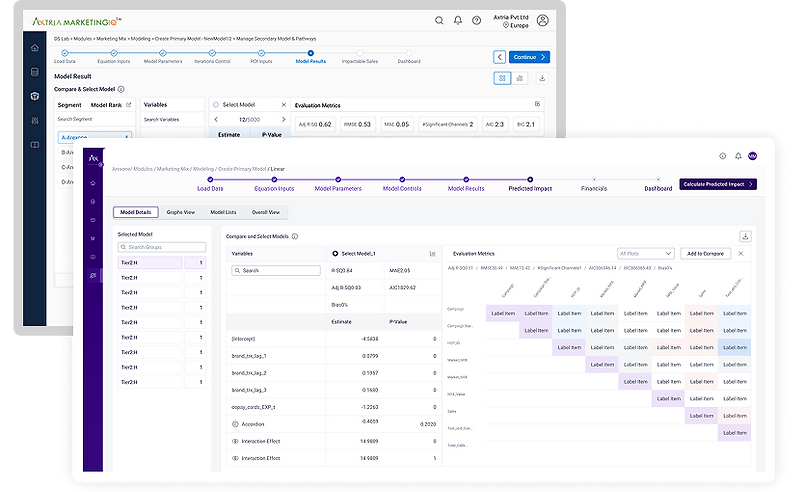Patient analytics
Project: Patient Analytics Platform for Rare Disease Cohorts
Role: Strategic Product Designer
Objective: Design a cloud-based, AI/ML-powered SaaS platform to enable pharmaceutical teams to build high-quality patient cohorts and analyze patient journeys, specifically targeting rare diseases.
Team: UX, Data Scientists, Developers, Marketing Strategist
Problem
Rare disease patient datasets are inherently sparse, fragmented, and inconsistent, making cohort creation highly complex. Skilled data scientists spend excessive time navigating incomplete or irrelevant data, resulting in inefficiencies, lack of standardization, and unreliable insights. High-quality patient cohorts are foundational for deriving actionable insights across marketing, sales, and forecasting.
Challenge
Analytics users faced fragmented dashboards and inconsistent workflows across regions. The goal was to design a unified experience within Axtria’s InsightsMAx ecosystem that simplifies insight discovery and enhances interpretability.
Approach
-
Defined information architecture and visualization frameworks to make predictive and prescriptive data actionable.
-
Embedded GenAI-assisted prompts that translate data into contextual narratives.
-
Unified design across InsightsMAx, SalesIQ, and CustomerIQ modules via a central Design System.

Impact
-
↓ 50% design–dev cycle time via reusable UX components
-
↑ 40% adoption of new analytics dashboards
-
Enhanced trust and explainability in AI-driven insights
As a Strategic Product Designer, I led the design of a rare disease patient analytics platform using a design thinking approach. I collaborated with data scientists and business teams to simplify complex cohort creation, addressing data inconsistencies and inefficiencies. By designing a low-code/no-code interface with real-time visualizations, reusable templates, and collaborative dashboards, we accelerated high-quality cohort creation and improved insight accuracy. The solution empowered stakeholders to derive actionable patient journey insights while maximizing efficiency and standardization across teams.
Marketing Intelligence Quotient (MIQ)
Project: Grow Marketing ROI through Customer Segmentation & Propensity Modeling
Role: Lead UX Designer
Objective: To design an intuitive, user-centered platform that simplifies complex marketing data, enabling marketers to quickly identify insights, take action, and make confident decisions without feeling overwhelmed.
Team: UX, Data Scientists, Developers, Marketing Strategist
Problem
Marketing teams were overwhelmed with data scattered across multiple systems.
-
Insights were hard to access, especially for non-technical users.
-
Dashboards were cluttered and slow to reveal ROI.
-
Poor integration frustrated teams using CRMs, analytics, and campaign tools.
-
Lack of real-time feedback limited agility in fast-moving campaigns.
Summary
At Marketing Intelligence Quotient, I helped marketers turn overwhelming data into actionable insights. By simplifying dashboards, prioritizing KPIs, and linking spend to outcomes, I designed a platform that enabled faster, smarter campaign decisions. Real-time alerts, segmentation, and propensity models allowed for personalized targeting at scale, while reducing cognitive overload. This project reinforced my approach as a Strategic Product Designer: designing with intention to connect user needs directly to measurable business impact.

Portfolio Optimization (Discovery)
Project: “BrandSpend IQ – Visual Portfolio Optimization for Marketing ROI”
Role: Lead UX Designer
Duration: 36 months
Team: UX, Data Scientists, Developers, Marketing Strategist
Problem
Users needed a way to efficiently allocate marketing budgets across a portfolio of brands, which could span multiple hierarchical levels (e.g., Geography, Therapeutic Area, Brand). The challenge was to help users define and visualize this complex portfolio structure clearly, understand the relationships between levels and values, and make informed budget decisions without being overwhelmed by the complexity.
Summary
When I approached portfolio optimization, the challenge was helping users allocate marketing budgets across complex, multi-level brand portfolios. I clarified key concepts—levels (categories) and values (instances)—through an interactive animation and designed a vertical top-down tree to make the hierarchy intuitive. By splitting the workflow into defining levels first and assigning values next, and building a React-based canvas board, I enabled users to construct portfolios confidently and see budget flows in real time. This approach simplified complexity, enhanced clarity, and empowered users to make informed allocation decisions efficiently.
